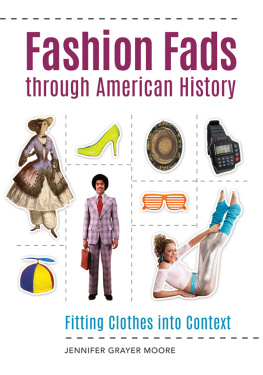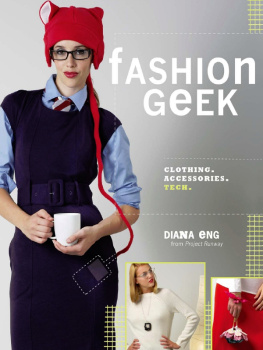
Amy Twigger Holroyd is a designer, maker, writer and researcher. Through her knitwear label, Keep & Share, she has been exploring the emerging field of fashion and sustainability since 2004. Her work has been sold and exhibited worldwide and featured in many books and publications, from
Vogue to
Fashion Theory. She is a senior lecturer in Design, Culture and Context at Nottingham Trent University.
A fashion tour de force. It is clothing where we the people, our ideas and our fingers nimble or otherwise matter.
Kate Fletcher, Professor of Sustainability, Design, Fashion at University of the Arts London, author of Craft of Use
Folk Fashion takes an in-depth look at the implications of the handmade clothing movement. Its a must-read for anyone interested in how the act of making affects our world.
Sarai Mitnick, founder of Colette Patterns and Seamwork Magazine
This book is an inspiring reminder of the wealth that making brings into our lives. From evoking the spirits of the craftspeople that came before us to creating more meaningful relationships with both the materials and our community as we go, Twigger Holroyd deftly shares what a force folk fashion can be.
Betsy Greer, author of Craftivism: The Art of Craft and Activism

For Caspian
Contents
I am immensely grateful to the knitters Alex, Anne, Catherine, Julia, Kiki and Margaret who took part in my PhD research project with such enthusiasm and generosity. Likewise, I sincerely thank the interviewees Carol, Christine, Laura, Rachael, Rosie and Tom for sharing their experiences and insights with me so openly. Many thanks, too, to the great bunch of people who have helped to run the Keep & Share knitting tent over the years, and the hundreds of people who have contributed to the communal projects hosted there: the countless conversations, as well as written comments, have contributed immeasurably to my understandings of homemade clothes. In a similar vein, I thank all those makers whose blogs, tweets, updates and images I have had such fun browsing, and everyone who has chatted to me about making, at workshops, projects and fairs. All of these encounters, however brief, have fed into my thinking. Thanks also to all those far too many to list who have supported my practice over the years. Special mention must go to Marissa Harmon for her fantastic assistance in running the knitting workshops.
I am grateful to Birmingham Institute of Art and Design (BIAD), a faculty of Birmingham City University, for funding my doctoral research; I thank my BIAD supervisors, Professor Colin Gale and Dr Anne Boultwood, for their invaluable guidance. Thank you to Professor Kate Fletcher and Professor Rebecca Earley for their inspirational leadership in the exploration of fashion, textiles and sustainability. I am grateful to my former colleagues at the University of Leeds and the Design Routes project, and particularly Professor Tom Cassidy, for their support. I thank Professor David Gauntlett for his encouragement and advice in the development of this book, and for many illuminating conversations about making. Many thanks to Deb Twigger for her tireless proofreading and for teaching me to sew all those years ago. Thanks also to Daz Twigger, Simon Holroyd and Rachael Matthews for taking the time to read the whole manuscript and offering such thoughtful feedback. I am grateful to my editor, Philippa Brewster, for her support and wise suggestions; likewise, I thank the anonymous peer reviewer for the expert insights which helped me to tighten up the text. Many thanks, too, to all those who kindly provided me with images for the book.
Huge thanks are due to Simon for helping me to develop my ideas through endless discussion, and for always making the tea. And finally, loving gratitude to Cass: thank you for not minding your mother combining cuddling with typing in your first few months of life, and for bringing me joy every day.
The Hereford Knitters
Alex is a retired chartered accountant. She is always busy, involved with two local walking groups and the local theatre. She enjoys gardening and knits a great deal, describing herself as obsessive about it.
At the time of the reknitting project, Anne worked full time as a social worker. She spends a lot of her spare time visiting friends and family in different parts of the country and recently returned to knitting.
Catherine spends much of her time caring for her disabled son. Before she had children she was first an artist and then an academic researcher. Although she has little time to herself, she has recently started making again.
Julia is retired and enjoys handicrafts, gardening, reading and music. She attends a weekly craft group, where she has learned new skills; she nearly always has more than one project on the go.
Kiki works two days a week and enjoys gardening, walking, reading, playing the guitar, cooking, socialising and holidays in her camper van. She describes her knitting career as a bit discouraging.
Margaret works part-time, doing accounts for small businesses. She and her partner own a wood, grow vegetables and keep sheep. For her, knitting is a lifelong interest and passion.
The Interviewees
Carol studied fashion and textiles when she was younger and returned to sewing a few years ago. She particularly enjoys working with vintage fabrics and patterns and is usually wearing something homemade.
Christine Cyr Clisset is a New York-based journalist and sewing blogger who runs the Thread Cult podcast, a series of fascinating interviews with textile creatives; she has also edited two best-selling crafts books (see daughterfish.com and threadcult.com).
Laura Blackwell is a textile designer who loves to make her own clothes, sharing her projects on her blog and via Instagram. She has recently started teaching dressmaking classes at a fabric shop in West Yorkshire (see kathyimlost.co.uk).
Rachael Matthews is an artist and owner of Prick Your Finger, a wool shop, school and gallery. She co-founded the Cast Off Knitting Club for Girls and Boys in 2000 and has authored three knit and crochet books (see prickyourfinger.com).
Rosie Martin is the director of creative fashion label, DIYcouture. She produces accessible visual sewing instructions for easily adaptable contemporary garments and runs clothes-making workshops in London (see diy-couture.co.uk).
Tom van Deijnen better known in the craft world as Tomofholland seeks to highlight the contemporary relevance of clothes repair through his Visible Mending Programme as well as being a dedicated hand knitter (see tomofholland.com).
Throughout the book I share the experiences of other makers via excerpts from their blogs. Links to these blogs can be found in the notes for each chapter.
What is folk fashion? Perhaps the words conjure up a mental image of a peasant blouse, richly stitched with hand embroidery, or perhaps they suggest a discussion of the great variety of regional textile traditions found across the world. But no: when I say folk fashion, I am not referring to specific styles of clothing, nor to established traditions of making. Rather, I mean the making and mending of garments for ourselves, family and friends; the items these activities produce; and the wearing of those clothes once they are made. I use folk fashion as a catch-all term: an umbrella concept that encompasses everyone involved in making their own clothes, and everything they make. Thus, folk fashion garments can be of any type whatsoever, with no fixed aesthetic.














